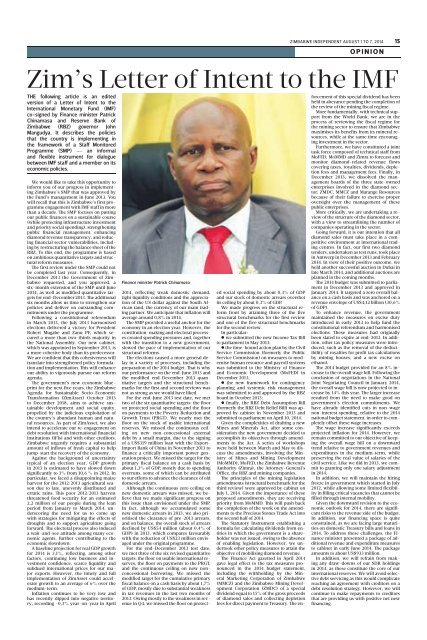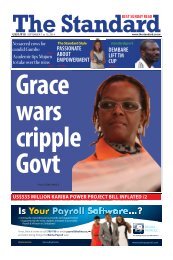Create successful ePaper yourself
Turn your PDF publications into a flip-book with our unique Google optimized e-Paper software.
Zimbabwe independent august 1 to 7, 2014 15<br />
opinion<br />
Zim’s Letter of Intent to the IMF<br />
THE following article is an edited<br />
version of a Letter of Intent to the<br />
International Monetary Fund (IMF)<br />
co-signed by Finance minister Patrick<br />
Chinamasa and Reserve Bank of<br />
Zimbabwe (RBZ) governor John<br />
Mangudya. It describes the policies<br />
that the country is implementing in<br />
the framework of a Staff Monitored<br />
Programme (SMP) — an informal<br />
and flexible instrument for dialogue<br />
between IMF staff and a member on its<br />
economic policies.<br />
We would like to take this opportunity to<br />
inform you of our progress in implementing<br />
Zimbabwe’s SMP that was approved by<br />
the Fund’s management in June 2013. You<br />
will recall that this is Zimbabwe’s first programme<br />
engagement with IMF staff in more<br />
than a decade. The SMP focuses on putting<br />
our public finances on a sustainable course<br />
(while protecting infrastructure investment<br />
and priority social spending), strengthening<br />
public financial management, enhancing<br />
diamond revenue transparency, and reducing<br />
financial sector vulnerabilities, including<br />
by restructuring the balance sheet of the<br />
RBZ. To this end, the programme is based<br />
on ambitious quantitative targets and structural<br />
reform measures.<br />
The first review under the SMP could not<br />
be completed last year. Consequently, in<br />
December 2013 the Government of Zimbabwe<br />
requested, and you approved, a<br />
six-month extension of the SMP until June<br />
2014, as well as modified quantitative targets<br />
for end-December 2013. The additional<br />
six months allow us time to strengthen our<br />
policies and deliver on outstanding commitments<br />
under the programme.<br />
Following a constitutional referendum<br />
in March 2013, the July 2013 harmonised<br />
elections delivered a victory for President<br />
Robert Mugabe and Zanu PF, which secured<br />
a more than two-thirds majority in<br />
the National Assembly. Our new cabinet,<br />
which was appointed in September 2013, is<br />
a more cohesive body than its predecessor.<br />
We are confident that this cohesiveness will<br />
translate into strengthened policy formulation<br />
and implementation. This will enhance<br />
our ability to vigorously pursue our reform<br />
agenda.<br />
The government’s new economic blueprint<br />
for the next five years, the Zimbabwe<br />
Agenda for Sustainable Socio-Economic<br />
Transformation (ZimAsset) October 2013<br />
to December 2018, aims to achieve sustainable<br />
development and social equity,<br />
propelled by the judicious exploitation of<br />
the country’s abundant human and natural<br />
resources. As part of ZimAsset, we also<br />
intend to accelerate our re-engagement on<br />
debt resolution with international financial<br />
institutions (IFIs) and with other creditors.<br />
Zimbabwe urgently requires a substantial<br />
amount of inflows of fresh capital to help<br />
jump-start the recovery of the economy.<br />
Against the background of uncertainty<br />
typical of an election year, GDP growth<br />
in 2013 is estimated to have slowed down<br />
significantly to 3% from 10,6 % in 2012. In<br />
particular, we faced a disappointing maize<br />
harvest for the 2012/2013 agricultural season<br />
due to late, unevenly distributed and<br />
erratic rains. This poor 2012/2013 harvest<br />
threatened food security for an estimated<br />
2,2 million of our people during the lean<br />
period from January to March 2014, underscoring<br />
the need for us to come up<br />
with strategies for mitigating the effects of<br />
droughts and to support agriculture going<br />
forward. The electoral process also induced<br />
a wait-and-see attitude among many economic<br />
agents, further contributing to the<br />
economic slowdown.<br />
A baseline projection for real GDP growth<br />
for 2014 is 3,1%, reflecting, among other<br />
factors, continuing low business and investment<br />
confidence, scarce liquidity and<br />
subdued international prices for our major<br />
exports. However, the timely and full<br />
implementation of ZimAsset could accelerate<br />
growth to an average of 6% over the<br />
medium-term.<br />
Inflation continues to be very low and<br />
has recently dipped into negative territory,<br />
recording -0,3% year-on-year in April<br />
Finance minister Patrick Chinamasa<br />
2014, reflecting weak domestic demand,<br />
tight liquidity conditions and the appreciation<br />
of the US dollar against the South African<br />
rand, the currency of our main trading<br />
partner. We anticipate that inflation will<br />
average around 0,8% in 2014.<br />
The SMP provided a useful anchor for the<br />
economy in an election year. However, the<br />
constitution-making and electoral processes<br />
created spending pressures and, together<br />
with the transition to a new government,<br />
slowed the pace of implementation of our<br />
structural reforms.<br />
The elections caused a more general delay<br />
in a variety of processes, including the<br />
preparation of the 2014 budget. That is why<br />
our performance on the end-June 2013 and<br />
the modified end-December 2013 quantitative<br />
targets and the structural benchmarks<br />
for the first and second reviews was<br />
not as strong as we would have liked.<br />
For the end-June 2013 test date, we met<br />
two of the six quantitative targets: the floor<br />
on protected social spending and the floor<br />
on payments to the Poverty Reduction and<br />
Growth Trust (PRGT). We nearly met the<br />
floor on the stock of usable international<br />
reserves. We missed the continuous ceiling<br />
on new non-concessional external<br />
debt by a small margin, due to the signing<br />
of a US$319 million loan with the Export-<br />
Import Bank of China in November 2013 to<br />
finance a critically important power generation<br />
project. We missed the target for the<br />
primary fiscal balance on a cash basis by<br />
about 1,3% of GDP, mostly due to spending<br />
overruns, some of which can be attributed<br />
to our efforts to advance the clearance of old<br />
domestic arrears.<br />
Although the continuous zero ceiling on<br />
new domestic arrears was missed, we believe<br />
that we made significant progress on<br />
this issue than envisioned under the SMP.<br />
In fact, although we accumulated some<br />
new domestic arrears in 2013, we also prioritised<br />
the clearance of pre-2013 arrears,<br />
and on balance, the overall stock of arrears<br />
declined by US$54 million (about 0,4% of<br />
GDP) in 2013, which compares favourably<br />
with the reduction of US$23 million envisaged<br />
under the original programme.<br />
For the end-December 2013 test date,<br />
we met three of the six revised quantitative<br />
targets: the floor on usable international reserves,<br />
the floor on payments to the PRGT,<br />
and the continuous ceiling on new nonconcessional<br />
borrowing. We missed the<br />
modified target for the cumulative primary<br />
fiscal balance on a cash basis by about 1,7%<br />
of GDP, mostly due to substantial weakness<br />
in tax revenues in the last two months of<br />
2013. Owing mostly to the weakness in revenue<br />
in Q4, we missed the floor on protected<br />
social spending by about 0,3% of GDP<br />
and our stock of domestic arrears overshot<br />
its ceiling by about 0,3% of GDP.<br />
We made progress on the structural reform<br />
front by attaining three of the five<br />
structural benchmarks for the first review<br />
and one of the five structural benchmarks<br />
for the second review.<br />
In particular:<br />
• we submitted the new Income Tax Bill<br />
to parliament in May 2013;<br />
• the time-bound action plan by the Civil<br />
Service Commission (formerly the Public<br />
Service Commission) on measures to modernise<br />
human resource and payroll systems<br />
was submitted to the Ministry of Finance<br />
and Economic Development (MoFED) in<br />
December 2013;<br />
• the new framework for contingency<br />
planning and systemic risk management<br />
was submitted to and approved by the RBZ<br />
board in October 2013;<br />
• finally, the RBZ Debt Assumption Bill<br />
(formerly the RBZ Debt Relief Bill) was approved<br />
by cabinet in November 2013 and<br />
submitted to parliament on April 10, 2014.<br />
Given the complexities of drafting a new<br />
Mines and Minerals Act, after some consideration<br />
the new government decided to<br />
accomplish its objectives through amendments<br />
to the Act. A series of workshops<br />
were held between March and May to discuss<br />
the amendments, involving the Ministry<br />
of Mines and Mining Development<br />
(MoMMD), MoFED, the Zimbabwe Revenue<br />
Authority (Zimra), the Attorney-General’s<br />
Office, the RBZ and mining companies.<br />
The principles of the mining legislation<br />
amendments (structural benchmark for the<br />
third review) were approved by cabinet on<br />
July 1, 2014. Given the importance of these<br />
proposed amendments, they are receiving<br />
priority from MoMMD. This will push back<br />
the completion of the work on the amendments<br />
to the Precious Stones Trade Act into<br />
the second half of 2014.<br />
The Statutory Instrument establishing a<br />
formula for calculating dividends from entities<br />
in which the government is a shareholder<br />
was not issued, owing to the absence<br />
of enabling legislation. However, we undertook<br />
other policy measures to attain the<br />
objective of mobilising diamond revenue.<br />
The Finance Act gazetted in April 2014<br />
gave legal effect to the tax measures pronounced<br />
in the 2014 budget statement,<br />
including the withholding by the Mineral<br />
Marketing Corporation of Zimbabwe<br />
(MMCZ) and the Zimbabwe Mining Development<br />
Corporation (ZMDC) of a special<br />
dividend equal to 15% of the gross proceeds<br />
of diamond sales and collecting depletion<br />
fees for direct payment to Treasury. The enforcement<br />
of this special dividend has been<br />
held in abeyance pending the completion of<br />
the review of the mining fiscal regime.<br />
More fundamentally, with technical support<br />
from the World Bank, we are in the<br />
process of reviewing the fiscal regime for<br />
the mining sector to ensure that Zimbabwe<br />
maximises its benefits from its mineral resources,<br />
while at the same time encouraging<br />
investment in the sector.<br />
Furthermore, we have constituted a joint<br />
task force composed of technical staff from<br />
MoFED, MoMMD and Zimra to forecast and<br />
monitor diamond-related revenue flows<br />
covering taxes, royalties, dividends, depletion<br />
fees and management fees. Finally, in<br />
December 2013, we dissolved the management<br />
boards of the three state-owned<br />
enterprises involved in the diamond sector:<br />
ZMDC, MMCZ and Marange Resources<br />
because of their failure to exercise proper<br />
oversight over the management of these<br />
public enterprises.<br />
More critically, we are undertaking a review<br />
of the structure of the diamond sector,<br />
with a view to streamlining the number of<br />
companies operating in the sector.<br />
Going forward, it is our intention that all<br />
diamond sales must take place in a competitive<br />
environment at international trading<br />
centres. In fact, our first two diamond<br />
tenders, undertaken as test runs, took place<br />
in Antwerp in December 2013 and February<br />
2014. In view of their positive outcome, we<br />
held another successful auction in Dubai in<br />
late March 2014, and additional auctions are<br />
planned in the coming months.<br />
The 2014 budget was submitted to parliament<br />
in December 2013 and approved in<br />
January 2014. It targeted a zero overall balance<br />
on a cash basis and was anchored on a<br />
revenue envelope of US$4,12 billion (30,6%<br />
of GDP).<br />
To enhance revenue, the government<br />
maintained the measures on excise duty<br />
introduced in early 2013 to help fund the<br />
constitutional referendum and harmonised<br />
elections. These measures had originally<br />
been slated to expire at end-2013. In addition,<br />
other tax policy measures were introduced,<br />
such as the removal of the deductibility<br />
of royalties for profit tax calculations<br />
by mining houses, and a new excise on<br />
ethanol.<br />
The 2014 budget provided for an 8% increase<br />
to the overall wage bill. Following the<br />
conclusion of negotiations in the National<br />
Joint Negotiating Council in January 2014,<br />
the overall wage bill is now projected to increase<br />
by 14% this year. The larger increase<br />
resulted from the need to make good on<br />
government’s election commitments. We<br />
have already identified cuts in non-wage<br />
non-interest spending, relative to the 2014<br />
national budget statement, in order to completely<br />
offset these wage increases.<br />
The wage increase significantly exceeds<br />
projected inflation for 2014. However, we<br />
remain committed to our objective of keeping<br />
the overall wage bill on a downward<br />
trend relative to government revenues and<br />
expenditures in the medium-term, while<br />
preserving the real value of salaries of the<br />
civil service. Like we did in 2013, we commit<br />
to granting only one salary adjustment<br />
in 2014.<br />
In addition, we will maintain the hiring<br />
freeze in government which started in July<br />
2012, while allowing some limited flexibility<br />
in filling critical vacancies that cannot be<br />
filled through internal mobility.<br />
Given the downward revision to the economic<br />
outlook for 2014, there are significant<br />
risks to the revenue side of the budget.<br />
In addition, our financing space is quite<br />
constrained, as we are facing large maturities<br />
on domestic Treasury bills and loans in<br />
2014. To address these challenges, the Finance<br />
minister presented a package of additional<br />
revenue and expenditure measures<br />
to cabinet in early June 2014. The package<br />
amounts to about US$933 million.<br />
In addition, we will refrain from making<br />
any draw-downs of our SDR holdings<br />
in 2014, as these constitute the core of our<br />
international reserves. We will avoid selective<br />
debt servicing as this would complicate<br />
reaching an agreement with creditors on a<br />
debt resolution strategy. However, we will<br />
continue to make repayments to creditors<br />
that are providing us with positive net new<br />
financing.


















